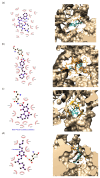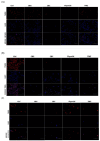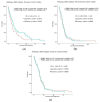Evaluating the Antitumor Potential of Cannabichromene, Cannabigerol, and Related Compounds from Cannabis sativa and Piper nigrum Against Malignant Glioma: An In Silico to In Vitro Approach
- PMID: 40565152
- PMCID: PMC12192948
- DOI: 10.3390/ijms26125688
Evaluating the Antitumor Potential of Cannabichromene, Cannabigerol, and Related Compounds from Cannabis sativa and Piper nigrum Against Malignant Glioma: An In Silico to In Vitro Approach
Abstract
Malignant gliomas, including glioblastoma multiforme (GBM), are highly aggressive brain tumors with a poor prognosis and limited treatment options. This study investigates the antitumor potential of bioactive compounds derived from Cannabis sativa and Piper nigrum using molecular docking, cell viability assays, and transcriptomic and expression analyses from public databases in humans and cell lines. Cannabichromene (CBC), cannabigerol (CBG), cannabidiol (CBD), and Piper nigrum derivates exhibited strong binding affinities relative to glioblastoma-associated targets GPR55 and PINK1. In vitro analyses demonstrated their cytotoxic effects on glioblastoma cell lines (U87MG, T98G, and CCF-STTG1), as well as on neuroblastoma (SH-SY5Y) and oligodendroglial (MO3.13) cell lines, revealing interactions among these compounds. The differential expression of GPR55 and PINK1 in tumor versus normal tissues further supports their potential as biomarkers and therapeutic targets. These findings provide a basis for the development of novel therapies and suggest unexplored molecular pathways for the treatment of malignant glioma.
Keywords: CCF-STTG1; Cannabis sativa; GPR55; PINK1; Piper nigrum; T98G; U87MG; cannabichromene; cannabidiol; cannabidiolic acid (CBDA); cannabigerol; glioblastoma; piperine.
Conflict of interest statement
The authors declare no conflicts of interest.
Figures


















Similar articles
-
Phytochemical analysis of leaf extract of Piper nigrum and investigation of its biological activities.Inflammopharmacology. 2025 Jun;33(6):3255-3277. doi: 10.1007/s10787-025-01701-5. Epub 2025 Apr 18. Inflammopharmacology. 2025. PMID: 40251438
-
Proteomics profiling reveals the potential targets of Apatinib inhibiting the proliferation of glioma U251 cell.Biochem Biophys Res Commun. 2025 Aug 15;775:152148. doi: 10.1016/j.bbrc.2025.152148. Epub 2025 Jun 4. Biochem Biophys Res Commun. 2025. PMID: 40493991
-
Nitric oxide synthase inhibitors as potential therapeutic agents for gliomas: A systematic review.Nitric Oxide. 2023 Sep 1;138-139:10-16. doi: 10.1016/j.niox.2023.06.002. Epub 2023 Jun 4. Nitric Oxide. 2023. PMID: 37279819
-
Metabolic models predict fotemustine and the combination of eflornithine/rifamycin and adapalene/cannabidiol for the treatment of gliomas.Brief Bioinform. 2024 Mar 27;25(3):bbae199. doi: 10.1093/bib/bbae199. Brief Bioinform. 2024. PMID: 38701414 Free PMC article.
-
Systematic Review of Molecular Targeted Therapies for Adult-Type Diffuse Glioma: An Analysis of Clinical and Laboratory Studies.Int J Mol Sci. 2023 Jun 21;24(13):10456. doi: 10.3390/ijms241310456. Int J Mol Sci. 2023. PMID: 37445633 Free PMC article.
References
-
- Kurdi M., Alkhotani A., Alsinani T., Alkhayyat S., Katib Y., Jastaniah Z., Sabbagh A.J., Butt N.S., Toonsi F.A., Alharbi M., et al. Effects of Radiotherapy Alone Versus Concomitant Radiotherapy with Temozolomide Chemotherapy on the Outcome of IDH-Wildtype Glioblastoma Patients. Clin. Oncol. 2025;38:103741. doi: 10.1016/j.clon.2024.103741. - DOI - PubMed
MeSH terms
Substances
Grants and funding
LinkOut - more resources
Full Text Sources
Medical
Research Materials
Miscellaneous

